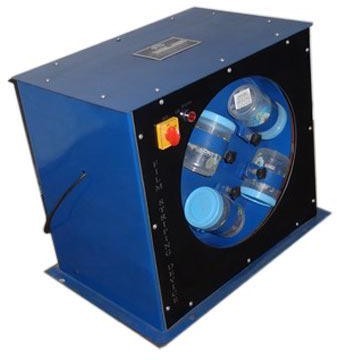
A Film Stripping Device is a laboratory apparatus used to evaluate the adhesive properties of bituminous materials in asphalt mixtures, specifically to determine the potential for stripping of asphalt from aggregate surfaces. Stripping is the separation of asphalt from the aggregate under the action of water, which can reduce the performance and durability of asphalt pavements.
- Temperature-Controlled Chamber:
- A chamber or bath that can be heated to a specified temperature to simulate field conditions. The temperature is typically adjustable to match different environmental conditions.
- Sample Holders:
- Devices or racks within the chamber to hold asphalt-coated aggregate samples during the test. These holders ensure that the samples are immersed in water at the correct temperature.
- Water Bath:
- A container filled with water that is used to simulate moisture conditions. The water can be heated to the desired temperature to mimic real-world conditions.
- Agitation Mechanism:
- Some devices include an agitation system to create movement in the water, simulating the action of traffic and ensuring uniform exposure of the samples to water.
- Timing and Control System:
- A system to control the duration of the test and monitor the temperature of the water. It ensures that the samples are exposed to the conditions for the correct amount of time.
- Measurement Tools:
- Instruments or devices to measure the extent of stripping or detachment of asphalt from the aggregate surface.
- Sample Preparation:
- Prepare asphalt-coated aggregate samples according to standard procedures. The aggregates are coated with a bituminous material and allowed to cool and set.
- Loading Samples:
- Place the asphalt-coated aggregates into the sample holders or racks within the device.
- Setting Conditions:
- Fill the water bath with water and set the temperature to the desired level. Adjust any agitation settings if applicable.
- Conducting the Test:
- Immerse the samples in the heated water bath. The samples are typically exposed for a specified period, which can vary based on the testing standards being followed.
- Observation and Measurement:
- After the specified time, remove the samples and inspect them for signs of stripping. Measure the extent of asphalt detachment from the aggregates.
- Recording Results:
- Document the amount of asphalt stripped from the aggregates. This data helps assess the potential for stripping and the quality of the asphalt mixture.
- Asphalt Quality Control:
- Evaluates the adhesion properties of asphalt mixtures to ensure they perform well under wet conditions and resist stripping.
- Material Testing:
- Tests different asphalt mixtures and aggregates to determine their resistance to stripping and overall durability.
- Research and Development:
- Assists in developing new asphalt formulations and additives that improve the adhesion between asphalt and aggregate.
- Durability:
- Helps ensure that asphalt pavements have sufficient resistance to moisture-induced stripping, which is crucial for long-term performance and durability.
- Performance Prediction:
- Provides insights into how asphalt mixtures will perform under wet conditions, helping to predict their behavior in real-world scenarios.
- Quality Assurance:
- Ensures that asphalt mixtures meet quality standards and specifications for resistance to stripping, improving the reliability of road construction and maintenance.
The Film Stripping Device is essential for assessing the performance and durability of asphalt mixtures, helping to ensure that pavements remain stable and durable under various environmental conditions.